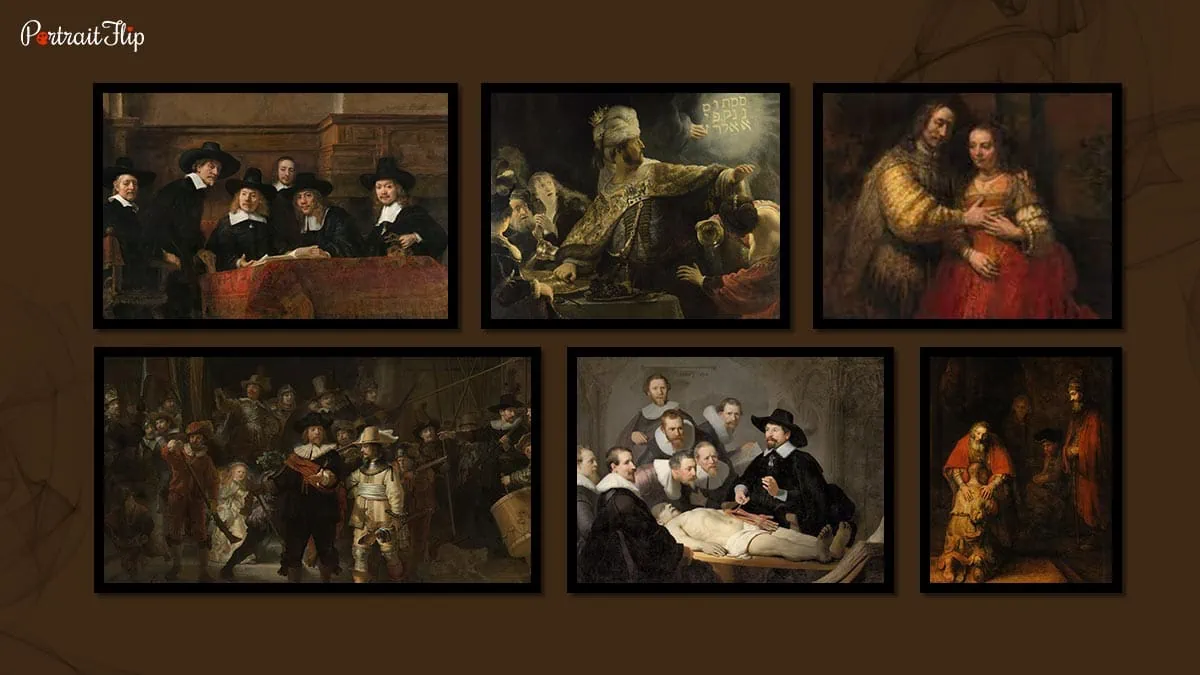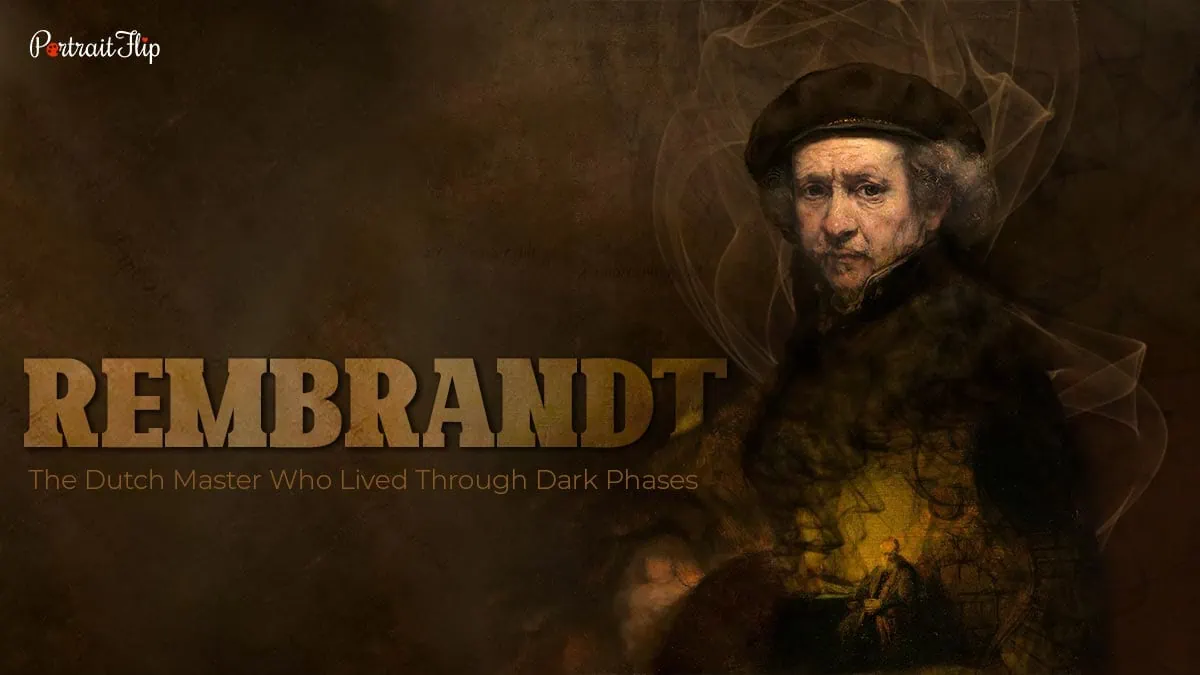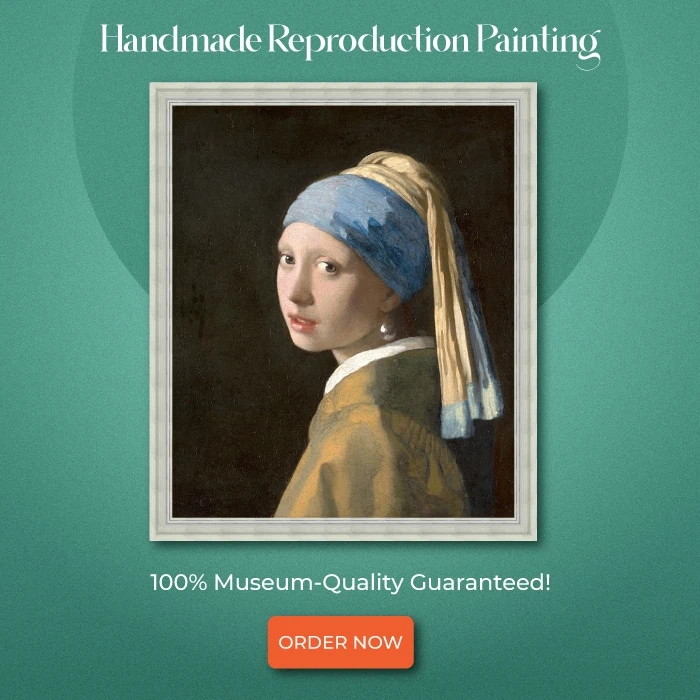Rembrandt’s life is a mystery!
Decoding it is difficult and perhaps next to impossible.
But thanks to those who owned and preserved the painter Rembrandt’s paintings, which helped us learn more about him as a painter, husband, and nonchalant by the time he left the world.
Rembrandt belonged to a well-to-do family, and unlike other famous painters, he had a happy and exciting childhood.
Childhood is the time when most of us indulge in playing, dancing, and other stupid and silly stuff.
But Rembrandt was different.
He would spend hours sketching and drawing scenes, which resulted in him traveling to Amsterdam.
His first visit was to pursue higher education, and his second was to become a master at Portrait and Landscape painting.
That was when tragedy and uninvited surprises knocked on his door, taking away everything, including his wife, property, and passion for art.
Table of contents
Early Life
The painter Rembrandt was born into a Catholic family in Leiden, the Republic Dutch, which is Netherlands in today’s times.

Rembrandt’s father worked in a mill, and his mother was the daughter of a baker; both were religious. Maybe that influenced him to incorporate some religious elements into his early work.
Like other Dutch Children, he went to elementary school, which he left when he was around 13, and took admission to Latin School in Leiden.
He discontinued the course halfway through and decided to move away to work as an apprentice for Jacob Van Swanenburg.
For the next couple of years, he worked under his guidance.
Jacob was phenomenal in his business and was the first to teach Rembrandt the basics of art.
He also made Rembrandt understand the role of skills and knowledge in becoming an expert.
The next biggest influence on Rembrandt after Jacob was Pieter Lastman, who lived in Amsterdam.
Rembrandt worked for him for a couple of months; he even helped Rembrandt hone his artistic skills.
Lastman was a famous history painter—an artist known for featuring biblical and religious subjects in complex settings.
The 17th century was brimming with different art techniques and styles; every art form that had been introduced in recent times would become prominent in the coming years.
The majority of artists chose religious, historical, biblical, and other fictional forms of art.
However, Rembrandt discovered his own new style, which was opposite to religious and Jesus art. Rembrandt, who was once a fan of history painting, got comfortable with the style that displayed reality.
Also Read: About Johannes Vermeer
Career

Rembrandt was a prolific Baroque painter and producer of over 300 pieces of art. Most of his art was produced in the suburbs of Leiden and Amsterdam.
There isn’t any official date or event when Dutch painter Rembrandt got his first break. But he was always into art and took on commissioned work ever since he knew how to paint and clean an oil artwork.
He was always seen as a figure who would inspire and bring the best out of his contemporaries. Therefore, Rembrandt had so many pupils, Gerrit Dou being the first.
In 1624, Rembrandt opened a studio in Leiden, whose ownership was shared with his contemporary Jan Lievens; it was the same place where he used to teach his students.
Students across the region would form a queue at his door to learn art from Rembrandt.
But Rembrandt would consider only the experienced.
At that juncture, Rembrandt was at his peak because he’d teach, draw, and etch—basically, whatever he liked.
He was so exceptional that his pupil’s parents compensated him with 100 guilders for his teaching.
Rembrandt’s Second Visit To Amsterdam
Hendrick Uylenburgh inspired Baroque painter Rembrandt to travel back to Amsterdam, where he produced several of his most expensive paintings.
For an outsider, it was fiercely competitive to build its name, especially when its locals were competitive and unwelcoming.
Despite all the odds, he made it, and he made it bigger, setting high standards for everyone.
Rembrandt became a household name because he came in from a different place altogether, and as a foreigner, one had to work for a year or two under the local master before they could be seen as masters of the guild.
But there were rumors that Rembrandt never traveled back to Amsterdam; perhaps he commuted to and from Amsterdam to work on commissioned paintings.
According to records, he moved to Amsterdam by the end of 1631, and the following years he met Saskia Ulyenburg, who later became his wife.
Rembrandt’s First Love

She was the cousin of Hendrick Uylenburgh, an art dealer with whom he stayed in his initial days in Amsterdam.
The entry of Saskia into painter Rembrandt’s life was truly a blessing, as he became a prominent member of the local guild of painters.
In later years, he became a reliable teacher for countless students, and a producer of substantial numbers of portraits.
His painting style and technique were staggering, unlike those of renowned and existing painters from Amsterdam.
Often, he’d cherish the days when he worked as a history painter, which helped him accomplish these milestones.
Rembrandt’s Arrival
His arrival stunned the art community as he, in no time, stole the thunder of each painter who was on the verge of making it big.
The work of Rembrandt justified his popularity as it limited attention to detail and mainly focused on the use of simple and dynamic contours.
Later on, his own style became a flaw, and experts began doubting his ability and skills when it came to portrait painting.
People would make remarks about his art, comparing him with novice painters.
Even a Dutch diplomat and art connoisseur, Constantijn Huygens, criticized Rembrandt’s work in his autobiography.
He mocked him, claiming that other painters would do great if they put themselves in Rembrandt’s shoes.
That remark made a significant impact on the painter Rembrandt’s life, and he would take assistance from his pupils and students to work in order to pacify the critics.
(Suggested: History of Painting)
Work
The Dutch master, Rembrandt, is undisputedly a famous painter of the 17th century.
The Dutch Golden Age produced a handful of geniuses; Rembrandt was one of them, whose works were replicated and recreated countless times.
These are some of his greatest and most expensive pieces of work.
1. The Night Watch

The Night Watch by Rembrandt has to be listed first, as it is widely popular for its existence and title.
This Baroque painting was made in the daytime, and the accumulation of dirt and aging of varnish over the years made its appearance darker.
Although its dirt layer was removed in the mid-20th century, the title it acquired remained the same.
The painter Rembrandt received several lucrative opportunities after the popularity of The Night Watch, which brought him closer to becoming rich.
2. The Storm on the Sea of Galilee

The only seascape ever painted by Rembrandt is The Storm on the Sea of Galilee.
Created in 1633, Rembrandt’s art depicts Jesus calming the unwavering waves, saving the lives of the 14 helpless souls.
It’s one of the early paintings by Rembrandt when he moved to Amsterdam and was into portrait art.
Rembrandt’ pride was lost for two decades, and in 1991 it was stolen from the Isabella Stewart Gardner Museum by two thieves in the disguise of police officers.
The Storm on the Sea of Galilee was pulled off while its frame was left on the wall, and the heist included Rembrandt’s other works.
The Baroque painter Rembrandt featured himself in the art, displaying the exaggerated drama of the Baroque Era with a sense of realism.
3. Bathsheba at Her Bath

Bathsheba at Her Bath, a stunning beauty, a classic and popular piece of the Louvre museum, had a gut-wrenching backstory.
The lady featured in this nude painting is Uriah’s wife, Bathsheba, who was being spied on by a King named David.
He saw her from the roof of his palace, and ever since, he has developed a sexual feeling for her.
David impregnated her, hoping that her husband, who was on the battlefield, would come back and sleep with his wife, giving David’s unborn child his own name.
But it didn’t go according to plan, as he refused to accept her, which resulted in his being sent on the front line, where he got martyred.
This nude painting by Rembrandt features Bathsheba in a way that shows her stuck between whether she should be faithful to her husband or obey King David. Her expression signifies the trauma she has gone through.
(Also Read: 12 Paintings By Raphael)
Marriage and Family Complications
Soon after becoming a prominent and leading figure in portraiture and history painting, the painter Rembrandt developed a romantic relationship with his contemporary’s cousin, Saskia.
Later, in 1934, both exchanged vows and became a happy and affluent couple in the town.
Saskia was the lucky charm, as Rembrandt made it to several prestigious board members.
Following several years, he moved to a bigger and more elegant house with his wife, and they started living their dream life together.
The couple was happy and prosperous together until a series of tragedies occurred.
Their first three children died within weeks of their birth, and in a few years, Rembrandt’s wife succumbed to tuberculosis.
The painter Rembrandt used to depict Saskia in his art before she even became his wife; he’d feature her in his drawings, paintings, and etchings, glorifying her charm and beauty.
Rembrandt had been bereaved for many years; first by the deaths of his children and then of his beloved wife.
Titus, their fourth child, survived infancy. Geertje Dircx took on the responsibility and became Titus’s dry nurse.
She was a childless widow and joined Rembrandt’s service in 1643.
In the next couple of years, she lived with Rembrandt as his son’s babysitter, but both ended up developing an illicit sexual relationship.
Lots of things had happened between them, from Rembrandt gifting her a diamond ring to him cheating on her with his housekeeper, Hendrickje Stoffels.
Rembrandt wasn’t the same man he was when he lived with his first wife, Saskia.
He was a changed man; perhaps Geertje Dircx brought out the worst in him, which drove him to the doors of court and made him bankrupt.
(Suggested: Wassily Kandinsky: An Artist With A Musical Vision)
Bankruptcy
When Saskia died in 1642, Rembrandt’s heart fell apart. He’d think of nothing but Titus, who was an infant.
He wanted someone to take care of his infant child. That’s when Pieter, who worked for Rembrandt, introduced his sister to Rembrandt.

Geertje joined the service as Titus’s dry mom, and for the next six years, she raised him like her own child.
During the course, she developed an illicit sexual relationship with the painter Rembrandt, which was, to her knowledge, a legal and romantic one.
But, on the other hand, Rembrandt wanted things to be under the carpet, as if he got married to her, he’d lose all his deceased wife’s inheritance, which he’d never want to happen even in his wildest dreams.
A few years later, when Geertje learned about Rembrandt’s intention, she confronted her and started blackmailing him.
Rembrandt’s Affair
At the time, Rembrandt developed another relationship with his housekeeper, Hendrickje, which resulted in the separation of Geertje and Rembrandt.
To settle the issue with Geertje, Rembrandt offered her 160 guilders plus a stipend of 60 guilders annually, which she threw away.
The relationship that sprouted out of utter respect and love became bitter and unhealthy with each passing day.
The Dutch painter Rembrandt wanted to resolve it amicably with the aid of some finance, which he felt was enough for Geertje. But she was so furious and rigid that she did not withdraw her request and expected more from Rembrandt.
The matter climbed up the steps of court, and legal proceedings began with both parties eventually losing almost everything they were trying to protect in the first place.
Geertje ended up in asylum as her own neighbors and family turned against her and supported the claim made by Rembrandt.
On the other hand, Rembrand’s fortune depleted heavily, and things for him began to turn upside down because of Rembrand’s splurging habits and legal matters.
Rembrandt’s Midlife Crisis
The Dutch painter Rembrandt would live beyond his means, take loans one after another, and overpromise to his new lover.
Maturing Titus began problematic for him as he’d be seen as the next heir to Rembrandt as he shut his mother’s family out.
Rembrandt, to balance his finances and regain stability, would host exhibitions, but they would end up disappointing him.
Geertje, on the other side, was freed from asylum due to her deteriorating health, and she thereafter sued Rembrandt over his false allegation, which threw her into a mental hospital.
Rembrandt declared bankruptcy as he had lost a large fortune in several matters and was now on the verge of selling whatever he owned, including art, etchings, and property.
The house given to Titus was even sold at auction, and Rembrandt and his family moved to a more modest house to sustain their livelihood.
The water went over his head when his creditor knocked on the door of the court. And Rembrand, out of his will, had to put everything on sale at lower prices.
Everything was taken away.
He was left with empty hands, as he had nothing but to regret the decisions he made—perhaps those that could’ve taken him to a better spot.
(Read: The Definitive Guide To Gustav Klimt)
Workshops
Rembrandt, in his lifetime, sketched countless portraits featuring people around him, his loved ones, and even himself.
His works, which he created, were mainly made in the workshops and art galleries of Leiden and Amsterdam.
Speaking of his workshops, he owned a couple of them, located in Amsterdam.
The first workshop he opened in Amsterdam was when he stayed with Jacob Pynas.
Later, Rembrandt invested in a couple of workshops where he produced art and tutored aspiring painters.
In fact, the commissioned work he’d take up would have his pupils’ contributions. The ones who came and studied under him, would do anything to repay him; they’d often work on projects Rembrandt found difficult.
The influence of Rembrandt’s art was heavy on his painters, and there were over 50 pupils who worked under him throughout his lifetime.
Painting Techniques
Rembrandt’s paintings and style left a profound impact on the art world of the 17th century as well as today’s.

Geniuses and talents were born in the Dutch Golden Age; Rembrandt was one of them, who worked on his craft and adapted techniques that he came across.
Perhaps that shaped him because his way of thinking about art was different from others.
That was the time when religious or Jesus paintings were slightly losing their audience, enabling artists to explore different painting styles and techniques.
The painter Rembrandt began drawing portraits, mainly featuring himself in different situations and appearances.
Rembrandt had a keen interest in portraits, and perhaps he’d paint himself every year because he wanted his pupils and admirers to see him growing mature.
The idea he truly believed in in making art was showing reality rather than displaying distorted versions of it, meaning Rembrandt wouldn’t draw scenes that appear positive and happy in art but not in reality.
However, Rembrandt’s thoughts didn’t go well throughout the 17th century and were considered ugly and absurd.
Painters from the Rembrandt period would make religious and Jesus art, as some patterns were seen repeated in this form of art.
The Dutch painter Rembrandt, on the other hand, had a different view. He knew religious scene art was declining, but the participation of painters in it wasn’t.
Despite that, he’d draw his portraits without following any rule or pattern.
Suggested Read: Deconstructing Dutch Artworks
Influence
The Dutch master was against the glorification of anyone, and he’d prefer drawing scenes that were real and were part of ordinary families.
The idea, which wasn’t backed by anyone, later became a big success, perhaps even more so in the 21st century.
The courage Rembrandt had and the attitude he carried to do nothing but something exceptional were remarkable.
Although he wasn’t the first to oppose norms, he was indeed renowned for it, and he worked and followed a few principles until his death.
He was kind of a rebellious artist who abandoned some techniques but still made it to the top, fighting against all the odds.
For him, there was no room for art that emphasized objective beauty, which is why portraits by Rembrandt were detailed and absolutely realistic.
The study of Rembrandt, or his art, for that matter, which is draped with mystery, revealed his twisted and shaken life experiences and marital affairs.
No matter what readers say or write about Rembrandt Van Rijn, he’s undisputedly one of the biggest influences on contemporary artists and will be because of his principles and madness for art.
Author’s Note
Thank you for reading this article to the end.
This was all about the journey of the famous painter Rembrandt Harmenszoon van Rijn.
We try our best to provide you with the most refined and researched information, so if you find this blog helpful, then do leave your valuable feedback in the comments.
Also, we are active on social media platforms, where we post amusing and valuable content around art.
We actively post on YouTube, so don’t forget to subscribe to our channel.
Suggested Read: About Leonardo da Vinci
Frequently Asked Questions
The full name of Rembrandt is Rembrandt Harmenszoon van Rijn.
Leiden and Amsterdam were the two places where the Dutch master Rembrandt created most of his art.
Jacob van Swanenburgh was the first to teach him the basics of art.






